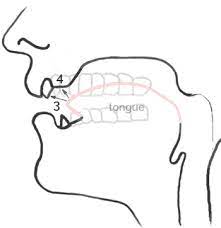3.1 Occlusive Consonants: P, T, K
Learning Objectives
At the end of this chapter you will:
- Know the main features of occlusive consonants.
- Be able to explain what a plosive sound is.
- Be familiar with the points of articulation of the sounds /p, t, k/
- Understand the difference in point of articulation between the English and the Spanish /t/.
- Practice hearing and articulating plosive and non-plosive /p, t, k/.
Occlusive consonants get their name from the fact that in order to be produced there needs to be a temporary occlusion or interruption of the air as it exits the mouth. When applying contrastive analysis to the English and Spanish /p, t, k/, we find that they are very similar. However, there is a very important difference, i.e, the fact that in English these consonants are “plosive.” A plosive consonant requires that pressure builds up behind the point of occlusion so when the blockage is released, the air escapes with great force, thus creating a small explosion, or puff of air. Spanish occlusives are not plosive. In fact, if English speakers are able to pronounce the Spanish /p, t, k/ as non-plosive sounds, they will have made huge strides in improving their pronunciation.
Regarding spelling, just like in English /p/ and /t/ are represented by the letters “p” and “t”. However, unlike English, the sound /k/ is generally written with a “c,” (ca, co, cu) or with “que,” and “qui”.
Like in English /p/ is bilabial and /k/ is velar. Unlike in English, where the /t/ is alveolar (the tongue touches the bumpy area behind the front teeth), in Spanish this sound is dental (the tongue touches the back of the upper teeth). In the diagram below #3 shows the point of articulation for the Spanish /t/ and #4 shows its English counterpart. Please pronounce the word “tea” in English and the the word “ti” in Spanish and try to feel the difference in your mouth.

It is important that you understand what you have learned in this chapter. Please take this quiz before continuing.
Now, please take this quiz indicating whether the sounds you hear are from English or Spanish.

ATTENTION: Remember that Spanish /p, t, k/ are not plosive. You must avoid producing a puff of air when pronouncing them.
The paper practice. Please watch the following videos that show the way you can use a piece of paper to practice the pronunciation of the English and Spanish /p, t, k/.
Let’s now practice the English /p, t, k/ and the Spanish /p, t, k/. Listen and repeat after the speakers.
| English | Spanish |
| commercial | comercial |
| tabulate | tabular |
| provider | proveedor |
| topology | topología |
| paper | papel |
| Paris | París |
| car | carro |
| Tina | tina |
| Teletubbies | Teletubis |
| Chemistry | química |
| patella | patela |
Let’s keep practicing. Repeat the words after the speaker.
| Contador |
| Tasa de intereses |
| Atacama |
| Carcomió |
| Té |
| Concomitante |
| Teté |
| Matrícula |
| Paralelepípedo |
| Papacito |
Self Analysis Activity

— Pablo, quiero tomar una taza de té o de café.
–Tomás, a ti te gusta más el chocolate o la coca cola?
–Tal vez Carlos se vaya para la tierra de Tito.
–¡Caramba, Tito, cuando comes la carne con cuchara te creen loco!
–Papá, quisiera tener tanta ropa como mi tío Teófilo.
–Métete Teté, que te metas, teté. Métete Teté, no lo repetiré (lyrics from a children’s song by the
Mexican composer Cri Cri).
Listen to your recording and answer the following questions. Answers will auto-save every 10 seconds..


